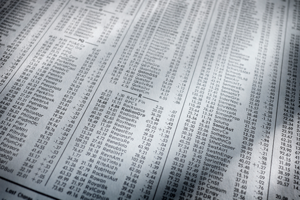by Dennis Tilley | Sep 6, 2016 | Trading Edges
 Periods of high volatility, sharp sell-offs and bear markets create an environment rich in trading and investment opportunities for those that remain level-headed and prepared. As prices recover and the next equity bull market develops, all risk-on trades generally work. Eventually the bull market ages, and finding new trading ideas becomes a bit more challenging.
Periods of high volatility, sharp sell-offs and bear markets create an environment rich in trading and investment opportunities for those that remain level-headed and prepared. As prices recover and the next equity bull market develops, all risk-on trades generally work. Eventually the bull market ages, and finding new trading ideas becomes a bit more challenging.
Developing successful trades in this environment requires creativity and hard work, searching for ideas that are good, yet not so well known as to be crowded, and therefore ineffective. This is easier said than done. Most traders tend to pile into similar mid- and late-cycle trades, which are often marginal with respect to an edge, or tend to be based on economic predictions and/or secular themes rather than exploiting another group of investors.
When too many traders are in the same trade, it becomes crowded. As you might expect, crowded trades lose their edge, and thus should be avoided. That is a good rule to live by, but even the best portfolio managers will occasionally join the crowd due to an extremely high conviction level associated with a trade. An asset class trader must then be aware that the price action associated with the trade will change when there are lots of fellow portfolio managers in the mix.
The concept of crowded trades has become standard trading lingo, much more so than it was 10 to 15 years ago, likely due to the growing popularity of hedge funds over that time period.1,2,3 Yet as far back as the 1960s, crowded shorts were a problem for hedge fund managers.4 In periods of limited opportunities, traders often read similar research reports, are attracted to the same outperforming assets, and in general, lack sufficient imagination to develop a new trade idea. In addition, larger hedge funds tend to implement global macro and asset class level trades due to capacity constraints.
Definition of a Crowded Trade
Whenever there’s too much money or too much attention showered on an asset type, you should expect lower returns, or losses in the case of a trade.
Pundits and fund managers throw around the crowded trade language all the time, often to justify their own positioning. (more…)
by Dennis Tilley | May 10, 2016 | Intermediate-Term Edge, Market Timing, Trading Edges, Trend Following
 In this blog I’ll examine the old “sell in May and go away” seasonal pattern associated with risky assets. It’s timely to consider this pattern since the markets are now entering the seasonally weak period. Furthermore, stock market performance has been relatively weak in a number of recent “strong periods,” such as in January 2016, November 2015 through January 2016, and November 2015 through April 2016, which often provides a foreboding tell of additional weakness during the traditional seasonal weak period of May through October.
In this blog I’ll examine the old “sell in May and go away” seasonal pattern associated with risky assets. It’s timely to consider this pattern since the markets are now entering the seasonally weak period. Furthermore, stock market performance has been relatively weak in a number of recent “strong periods,” such as in January 2016, November 2015 through January 2016, and November 2015 through April 2016, which often provides a foreboding tell of additional weakness during the traditional seasonal weak period of May through October.
Seasonality as a trading edge is also worth considering because trend following has become very trendy these days, with billions of dollars flowing into this discipline every year via managed futures funds. The problem with these flows is that the effectiveness of trend following diminishes as more assets are devoted to the discipline, since trend following is naturally capacity constrained due to high turnover (>200%) and the liquid demanding nature of trading. It seems that trend following is crowded.
At this point in time, it may be interesting to examine other market timing signals as an alternative way to add and reduce risk exposure. One such approach is seasonality, which is probably underutilized by the asset class trading community and thus might be more effective than trend following over the near term.
The seasonal pattern has been well known for decades – the stock market’s best period is from November through April, and its poor-performing period is from May to October. This is not the case every year, but on average this seasonal pattern has held up really well with stock markets around the world for decades.
Academics call this pattern the Halloween effect since the buy signal is generated by buying at the close on October 31 every year and the sell signal is on every April 30. What’s amazing is that seasonality has not been arbitraged away, even though the cost of implementing a seasonal trading system has been low since the 1980s. The old adage of “sell in May and go away” still works! (more…)
by Dennis Tilley | Apr 1, 2016 | Short-Term Edge, Trading Edges, Trend Following
 A stale pricing edge occurs when a security or fund can be purchased or sold at a price that is stale with respect to current up-to-the-second information. This trading edge is as fleeting as a twenty dollar bill sitting on a busy sidewalk. For instance, if the price of a U.S. equity closed-end fund is sitting at bid $10, ask $10.10 for most of the day without trading activity, and the S&P 500 trades up 2% during the day, the ask price of $10.10 may be too low, and therefore, stale. Then buying at the bid can provide a risk-free profit (if hedged by an S&P 500 short) of at least 10 cents, since the fund should be trading at $10.20/$10.30.
A stale pricing edge occurs when a security or fund can be purchased or sold at a price that is stale with respect to current up-to-the-second information. This trading edge is as fleeting as a twenty dollar bill sitting on a busy sidewalk. For instance, if the price of a U.S. equity closed-end fund is sitting at bid $10, ask $10.10 for most of the day without trading activity, and the S&P 500 trades up 2% during the day, the ask price of $10.10 may be too low, and therefore, stale. Then buying at the bid can provide a risk-free profit (if hedged by an S&P 500 short) of at least 10 cents, since the fund should be trading at $10.20/$10.30.
You’ll never find stale prices with liquid large cap equities or ETFs. Only rarely do they occur with securities that don’t trade very often, such as closed-end funds. The stale price edge is not backtestable with price data since simulated orders would have affected prices at the time.
Generally, we’d expect stale price opportunities to occasionally occur with illiquid stocks that trade with a wide bid-ask spread, with very little size offered. Stale prices may also emerge when transaction costs are high (perhaps due to a financial transaction tax), or when markets are highly volatile. In the heat of a stock market crash, when 10% up and down days are the norm, we’d expect a few stale price opportunities to emerge. Getting back to the U.S. equity closed-end fund discussed above, if the S&P 500 ramped 5% in the last hour of the day, and the closed-end fund lagged up only 2%, then perhaps that’s an opportunity to buy at the ask, and expect its price to eventually catch up (possibly the next morning).
Funds are the bread-and-butter tools for asset class traders – ETFs, ETNs, closed-end funds, open-end funds, limited partnerships, etc. There are stale pricing opportunities that can occur with investment funds from time to time.
Most notable was the stale pricing associated with open-end mutual funds. This advantage is no longer available today, but it represented a structural edge from the 1980s to the early 2000s. In his book The New Market Wizards, Jack Schwager profiled one trader, Gil Blake,1 who used this edge in the 1980s to produce an annualized return of 45% per year over 12 years. Mr. Blake actively traded Fidelity sector funds to generate those returns, switching in and out of funds every day. Interestingly, he was unaware of why the strategy worked, when what he was doing was systematically exploiting stale pricing. At that time, mutual fund prices exhibited a daily serial correlation because many of the securities held in the fund had stale prices when used to calculate the daily close-of-business net asset value (NAV). (more…)
by Dennis Tilley | Feb 26, 2016 | Asset Classes, Intermediate-Term Edge, Investing, Trading Edges
 The beginning of the year marks the time when chief investment officers, market strategists and other chief prognosticators publish their top investment themes. Barron’s also publishes their much anticipated “round table” issues in mid to late January, which pull together top investors to discuss the state of the markets and where they see investment opportunities.
The beginning of the year marks the time when chief investment officers, market strategists and other chief prognosticators publish their top investment themes. Barron’s also publishes their much anticipated “round table” issues in mid to late January, which pull together top investors to discuss the state of the markets and where they see investment opportunities.
There are hundreds of firms producing research all the time, most of it free. The big Wall Street firms produce enormous amounts of content, but so do practically all buy-side investment management firms these days. If you’re not careful, combing through research reports for trading and investment ideas can absorb all of the day. There are also the independent firms such as Ned Davis Research, BCA Research and the Leuthold Group, which are very expensive, but provide lots of interesting and useful information for asset class traders.
Common sense suggests that you can’t just read the research, implement the trades suggested and expect to outperform the market. That would be too easy. This is the case even for costly research from the independents, because after all, tens of thousands of professional portfolio managers can afford these services.
For an asset class trader, reading research and market commentary is important, primarily so you understand what everyone else is thinking, become aware of crowded trades and estimate what information is already priced into the markets. Every once in a while, a new piece of information is gleaned or a new way of thinking about an asset class is found. If discovered ahead of most other market participants, this information can be the seed of a new trade.
Thought Leaders
At any point in time, there are industry thought leaders who seem to have a special knack for investing and trading the markets. When they speak, I pay careful attention because the probability of discovering a new trade idea from them is much higher than reading the everyday, run-of-the-mill content.
Generally, these thought leaders are very experienced, talented and rich. They’re not inhibited by career risk. Their motivations are aligned with us, because being right about an investment theme is the most important goal associated with speaking publically since the prediction is on the record. Contrast this motivation with that of research content providers and newsletter writers, where maximizing readership is the primary goal. (more…)
by Dennis Tilley | Feb 3, 2016 | Uncategorized
I’ve been delayed in posting the next blog entry due to my current heavy work load, which is intensified by recent market conditions. This will happen occasionally. Our clients come first, and this blog will have to take a back seat when my daily workload becomes too intense.
My target posting rate is one per month. There is no rush. The primary purpose of the blog is self-mastery, which is ultimately a long-term pursuit.
In addition, there are times when a blog post I’m working on just doesn’t come together well. As I write about a particular subject, inconsistencies cause me to rethink the premise. That is the purpose of the blog – to explore the nuances of what works in trading asset classes. I’m currently working on a half dozen blog posts in various forms, but with each I’ve hit stopping points where the logic is not complete.
Recently, Alex Golubev and I worked on the concept of divergences. Throughout my career I’ve taken notice of divergences when trading asset classes. When looking at past data we see a relationship between credit spreads and future S&P 500 returns, similar to what has been discussed in the news recently. I had hoped to generalize the concept to all sorts of risky asset classes, yet the data did not support that view. So perhaps, I may have to adjust my use of that concept in the future.
I also intended to write about using non-trend information to trade S&P 500 movements, such as valuation, sentiment, and cycles. In addition, I planned to write about back-testing issues associated with this sort of information. However, our work on divergences has caused me to reexamine the use of non-trend information. This is especially important because trend following has become so popular lately; there may be value in using these non-trend indicators in the future.
Due to the infrequency of blog posts, I highly encourage all readers to sign up for the automatic email notification system.
Have a prosperous 2016.
-Dennis
 Periods of high volatility, sharp sell-offs and bear markets create an environment rich in trading and investment opportunities for those that remain level-headed and prepared. As prices recover and the next equity bull market develops, all risk-on trades generally work. Eventually the bull market ages, and finding new trading ideas becomes a bit more challenging.
Periods of high volatility, sharp sell-offs and bear markets create an environment rich in trading and investment opportunities for those that remain level-headed and prepared. As prices recover and the next equity bull market develops, all risk-on trades generally work. Eventually the bull market ages, and finding new trading ideas becomes a bit more challenging.
 In this blog I’ll examine the old “sell in May and go away” seasonal pattern associated with risky assets. It’s timely to consider this pattern since the markets are now entering the seasonally weak period. Furthermore, stock market performance has been relatively weak in a number of recent “strong periods,” such as in January 2016, November 2015 through January 2016, and November 2015 through April 2016, which often provides a foreboding tell of additional weakness during the traditional seasonal weak period of May through October.
In this blog I’ll examine the old “sell in May and go away” seasonal pattern associated with risky assets. It’s timely to consider this pattern since the markets are now entering the seasonally weak period. Furthermore, stock market performance has been relatively weak in a number of recent “strong periods,” such as in January 2016, November 2015 through January 2016, and November 2015 through April 2016, which often provides a foreboding tell of additional weakness during the traditional seasonal weak period of May through October. A stale pricing edge occurs when a security or fund can be purchased or sold at a price that is stale with respect to current up-to-the-second information. This trading edge is as fleeting as a twenty dollar bill sitting on a busy sidewalk. For instance, if the price of a U.S. equity closed-end fund is sitting at bid $10, ask $10.10 for most of the day without trading activity, and the S&P 500 trades up 2% during the day, the ask price of $10.10 may be too low, and therefore, stale. Then buying at the bid can provide a risk-free profit (if hedged by an S&P 500 short) of at least 10 cents, since the fund should be trading at $10.20/$10.30.
A stale pricing edge occurs when a security or fund can be purchased or sold at a price that is stale with respect to current up-to-the-second information. This trading edge is as fleeting as a twenty dollar bill sitting on a busy sidewalk. For instance, if the price of a U.S. equity closed-end fund is sitting at bid $10, ask $10.10 for most of the day without trading activity, and the S&P 500 trades up 2% during the day, the ask price of $10.10 may be too low, and therefore, stale. Then buying at the bid can provide a risk-free profit (if hedged by an S&P 500 short) of at least 10 cents, since the fund should be trading at $10.20/$10.30. The beginning of the year marks the time when chief investment officers, market strategists and other chief prognosticators publish their top investment themes. Barron’s also publishes their much anticipated “round table” issues in mid to late January, which pull together top investors to discuss the state of the markets and where they see investment opportunities.
The beginning of the year marks the time when chief investment officers, market strategists and other chief prognosticators publish their top investment themes. Barron’s also publishes their much anticipated “round table” issues in mid to late January, which pull together top investors to discuss the state of the markets and where they see investment opportunities.
